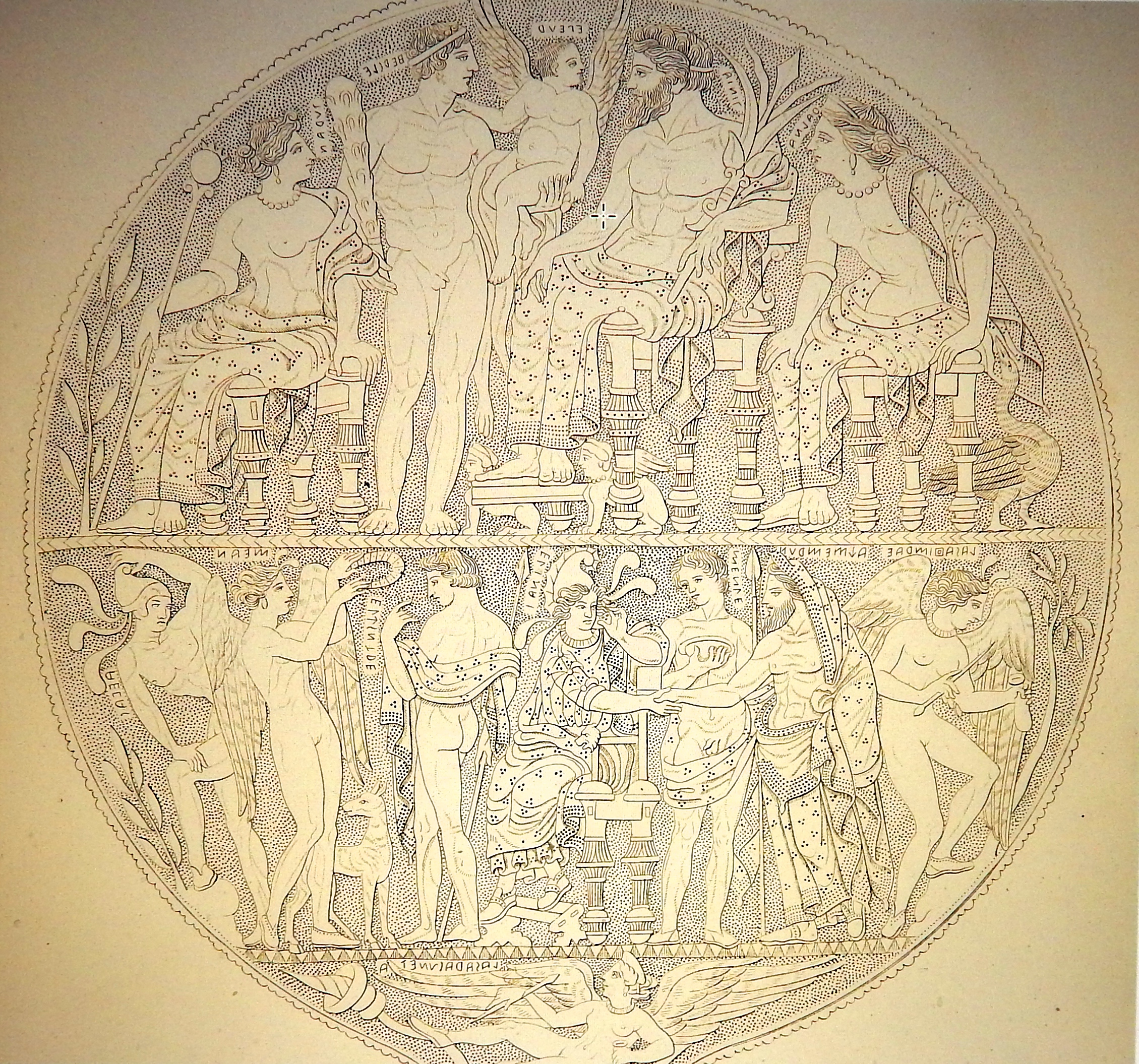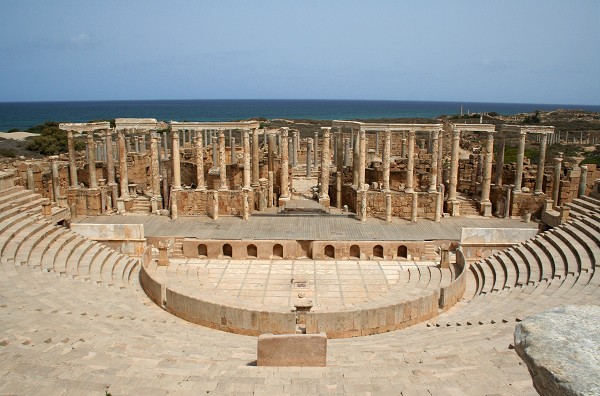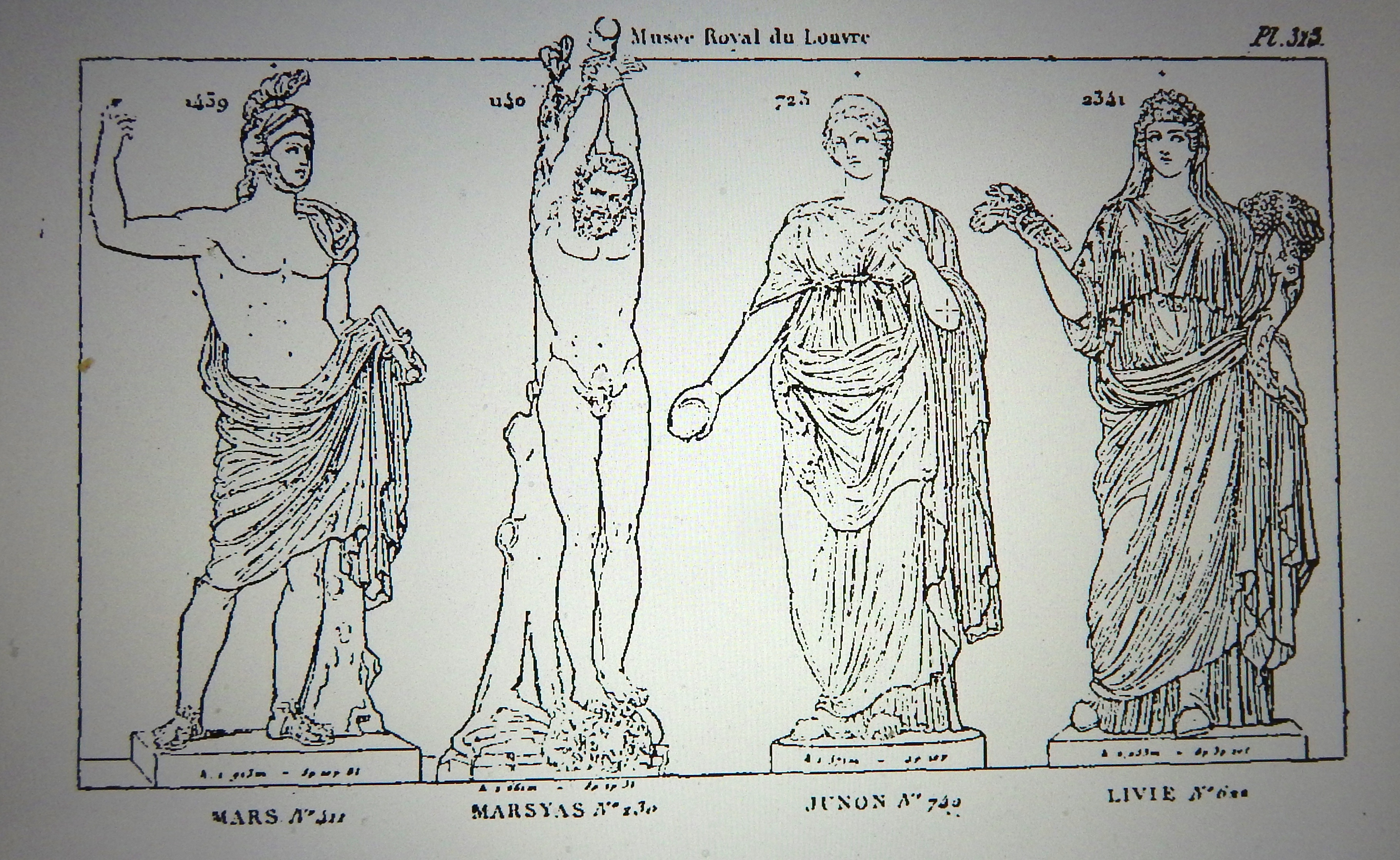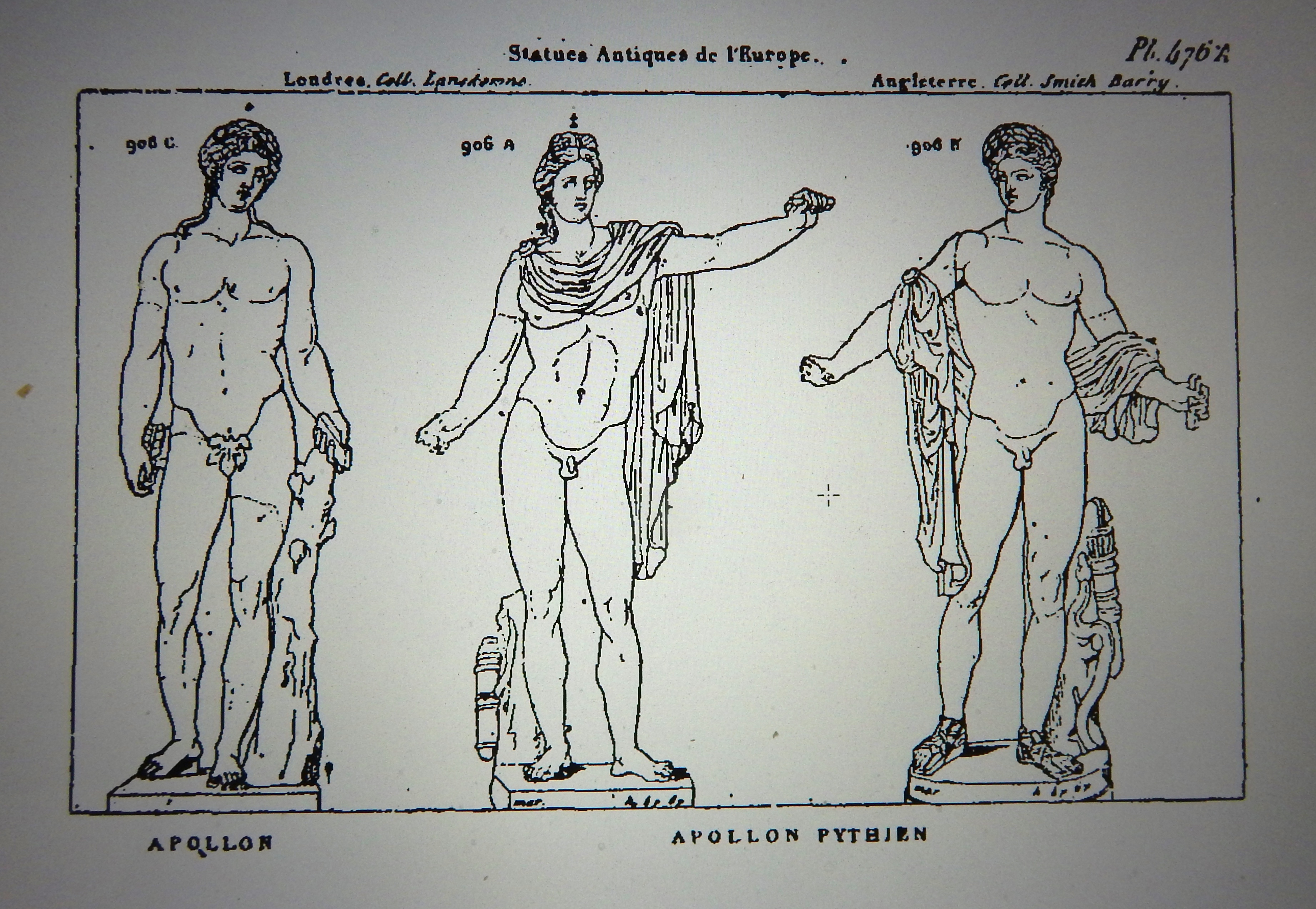Pantomime: The History and Metamorphosis of a Theatrical Ideology: Table of Contents
PDF version of the entire book.
The Pose
However, knowledge of this repertoire of performance devices does not explain the narrative logic of pantomime action. Rather, it amplifies the perception that the purpose of narrative organization of action is to reveal the virtuosity and personality of the performer rather than the psychology of the character impersonated or the authority of the character’s mythic origin. The story was “about” the performer’s ability to assume different identities and manipulate the theatrical devices necessary to achieve satisfactory “metamorphosis.” Pantomimes became more competitive by escalating the sensationalism of stunts and enactments, particularly of lurid female roles, such as Leda, Semele, Pasiphae, and Ariadne. Audiences apparently reveled in the spectacle of male performers impersonating mythic women giving birth to gods and heroes, or such fantastic metamorphoses as Minerva born fully grown and armed out of the head of Jupiter, although how stunts like these were actually performed still remains the subject of speculation. Moreover, according to Plutarch (IX.15.747), a great measure of performance virtuosity lay in the performer’s skill at executing poses. The performer’s movements, which Plutarch calls “phrases,” functioned as transitions between poses (Plutarch 1961: 289). The narrative consisted of a series of moments whose climax was a pose, the “terminating point of the movements” (Plutarch 1961: 289). A pose initiated a movement and then ended it to become the measure of transformation from one condition or identity to another. The audience contemplated the pose as if gazing at an artwork and evaluating it “like figures in a painting” (291). Writing two hundred years later, Libanius (LXIV.118) also mentions the importance of poses: “For [the performers] spin around us as though they have wings, and they finish in a motionless position as if they were fixed with glue. And with the position the picture presents itself. Another greater effort is to come to a stop at the same time as the song” (Malloy 2014: 175). Citing ancient authorities, Athenaeus, in the Deipnosophistae (I.21-22), written around 210-215 CE, suggests that alternating dance movements with poses date back at least to the time of Aeschylus (Athenaeus 1927: 95-96).
Salomon Reinach’s (1858-1932) comprehensive inventory of Greek and Roman statuary, compiled over a span of thirty years (1885-1912), provides an excellent comparative description of pose conventions that pleased audiences of ancient sculpture across several centuries. But Reinach’s endless inventory reveals that while ancient audiences persistently exhibited a taste for dramatic poses in sculpture, they did not pursue a taste for complexity of pose, in the sense of physical contortion or manifestations of intense physical exertion. Pose implied poise or “rest,” as Plutarch called it, an impression of energy and power ready for release or an idealized command of great strength molded within a disciplined body [Figure 17]. Statuary audiences seemed more appreciative of subtle differences in basic heroic poses than of striking originality in a pose. It is difficult to find evidence that the pantomime use of pose contradicted the taste for idealized poise in statuary. A pose, after all, is an opportunity to gaze at a body, a form, rather than an action. Furthermore, we should remember that for ancient audiences, statuary appeared in an architectural or design environment rich in delicate, brilliant color effects and attention to the manipulation of light and shadow. It is doubtful that pantomimes were any less attentive to color effects in the choice of mask, costume, and props to adorn a pose. In other words, even the same pose might cast a different effect if the performer simply wore a different mask and garment [Figure 11].


Just as useful for an understanding of pose aesthetics are the numerous Etruscan bronze mirror images catalogued by Eduard Gerhard (1795-1867) over several decades (1843-1897). “Decorated mirrors seem to have been an Etruscan specialty, unmatched in Greek art” (Brendel 1978: 201). These images, produced in the fifth and fourth centuries BCE, not only convey a greater sense of physical intimacy than statuary; they tend to indicate a greater sense of movement as a result of their linear rather than plastic organization of the image. Only occasionally do the mirror images depict solitary figures. The artists obviously favor crowded group tableaux and only occasionally images of pairs [Figure 18]. An exceptional dramatic intensity pervades nearly all the thousands of images recorded by Gerhard: the artists delight in showing mysterious tensions, in producing conflicting perceptions of actions. The mirrored identity of the mirror holder “emanates” from or perhaps just mingles with the mythic identities engraved on the back of the reflective surface. Indeed, what is remarkable about the mirror scenes is the difficulty of differentiating poses from actions, which often coincides with the difficulty of differentiating gods from mortals. The voluptuousness, the erotic glamour of the images, saturated with so much nudity, is perhaps not surprising in objects designed to amplify consciousness of personal beauty. Nevertheless, the images ubiquitously suggest that for the Etruscans, dramatic power arises from the closeness of bodies, from scenes that provoke uncertainty about which body dominates perception. This aesthetic results from a compression of the space containing the bodies, from a pleasure in seeing bodies “revolt,” as Brendel (1978: 66) observes, against the forms that contain them.

I do not mean to imply that the Etruscans displayed no enthusiasm for solitary figures nor that the Romans had no interest in representing intimacy. Rather, in the mirror images, the Etruscans revealed an attitude toward the basis of dramatic action that was unique and not shared by the Romans nor even by the Greeks. For the Etruscans, dramatic action arose from the sensuous power of bodies to compress space and circumscribe it. They perhaps distrusted too much the capacity of language to explain motives for action, and thus they did not invest much faith in literature to create a mythic cosmos through which one could decipher human destinies (see Brendel 1978: 144-145). Dramatic language somehow obfuscated or inhibited perception of the body in action. The Etruscan theater, at least as the Romans apparently understood it, evolved in relation to the perfection of a dance imagination and not in relation to literary innovation. The Romans cultivated a far more confident attitude toward the capacity of language to motivate and organize action, but they shared with the Etruscans the belief that dramatic language obfuscates perception of the body (the performer) by refracting perception toward an abstract imaginary, otherwise known as a “character.” Drama in this sense was not so much the revelation of a mythic level of identity within the body as it was the revelation of the body’s capacity to assume or project multiple identities. Human power did not reside in affirming or authenticating mythic forces; it resided in the body’s capacity to aestheticize reality and make reality (rather than representation) the measure of aesthetic experience.
But the Romans differed from the Etruscans in their understanding of the body’s aesthetic value. They saw how the body created or expanded space, rather than circumscribed it. In their art, the Romans showed greater enthusiasm than the Etruscans for representing space and incorporating space into representation, which is perhaps why they were slow to adopt painting as an art and then, after the brief, extraordinary period of the Second, Third, and Fourth Styles (late first century BCE to early second century CE), devoted their artistic energies to other media. In any case, they treated painting as an extension of architecture, a scenic backdrop to lived experience, rather than as a self-contained mode of representation. Imaginative painting of buildings and statues, however, preoccupied them until the end of the empire. Even in their wall paintings, the Romans displayed greater interest than the Etruscans in investing space with aesthetic energy and in dramatizing the space between bodies. This pleasure in revealing the “power” of space is a central feature of the imperial aesthetic. It helps explain why the Romans, across several centuries, could build a monumental theater culture throughout the Mediterranean world without feeling any serious urge to compose any literary drama for it. They relegated dramatic language, dialogue, to the lowly street theater of the mimes. They built wide, shallow stages that could accommodate huge, frieze-like throngs of bodies, but these stages never inspired dramatists to write anything for them [Figure 19]. When they bothered with drama at all, which was mostly during the Republic, literary talents wrote for an improvised performance environment and not for the grandiose architectural monuments that emerged throughout the ancient world during the Empire. Indeed, these great and magnificent theaters were more suited to dramatizing the grandeur of a solitary figure in movement than to providing an engaging motive for interactive action between speaking bodies assembled on them.

The Roman concept of “spectacle” favored work that blurred distinctions between reality and representation. The aesthetic reality of the theater, as the Romans perfected it, should exceed whatever one could imagine being performed in it. Myth provided a cosmic rationale for action in the world, but myth was credible to the extent that it amplified uncertainty about the difference between reality and representation. Or rather: uncertainty about the difference between reality and representation issued from a deeper uncertainty about the relation between life and death and the degree to which death was somehow an extension of life. To aestheticize reality was to transform fear of death into a powerful aesthetic experience. Roman spectacles, encompassing forms of performance on a much larger scale than could appear on a theatrical stage, often accommodated a pervasive urge to see violent death as a thing determined by a human (rather than divine) aesthetic impulse. But the Romans probably appropriated even this philosophical perspective, if we consider the tomb paintings of gladiators in Paestum and indeed the evidence concerning the origins of the gladiatorial combats in either the Etruscan or Oscan cultures (cf., Pontrandolfo 1992). In addition to gladiatorial combats, violent death contributed to the aesthetic enhancement of reality in chariot races, wild beast shows, naumachia(staged sea battles), or such presumed instances as when in the performance of a play preceding a gladiatorial game, the death of an imaginary character entailed the actual execution by the sword of a prisoner substituted for the actor who until then had impersonated the character. It would appear that actual death was never a component of pantomime performance, insofar as the pantomimes themselves did not find a place for it in their choreographies. The very idea of solo dance performance would seem to preclude any possibility, short of suicide, of seeing death as anything but a representation, an impersonation, which was certainly done often enough.
But pantomime performance involved a wider domain of activity than the choreographies that appeared in performance spaces designated for them, and this domain of pantomime performance did sometimes include violent death. The Emperor Nero (reigned 54-68 CE) eventually ordered the death of the pantomime Paris (?-67 CE) because the actor had too much knowledge of the Emperor’s crimes, because the actor had become a “dangerous rival” to the Emperor, or because he, the Emperor, had not made sufficient progress in learning the art from the actor (Tacitus, Annales 13. 19-22; Suetonius, Nero54). According to Tacitus, when the Emperor Claudius (reigned 41-54 CE) learned that his wife Messalina was engaged in an affair with the popular pantomime Mnester (?-48 CE), the dancer, a slave earlier compelled by Claudius to obey any command of Messalina, displayed an exceptionally Stoic response to the announcement from the Praetorian guard that they kill him immediately by order of the Emperor; he accepted a sword from a guard and stabbed himself. In 83 CE, the Emperor Domitian (51-96) also had a pantomime executed who had become the lover of the Empress Domitia Longina (Suetonius, Domitian, 3.1). Such scandalous stories, which could hardly have remained concealed from the public, no doubt intensified perception of the pantomime as a dangerous art. Leppin (1992: 190, 227, 247, 259, 267, 290, 295, 296) lists the known gravestone inscriptions that mention pantomimes or flute players who died as children or adolescents. Pliny (De natura, 7.184) remarks that two knights died after they slept with a pantomime named Mysticus. But pantomime performance could prove deadly for spectators as well as performers. Riots provoked by pantomime performances, which receive more detailed discussion later, occasionally became a serious social disorder from reign of Tiberius until the Fifth Century, especially in Antioch during the fourth century, when numerous spectators died as a result of clashes between rival fan clubs. “De funambulo,” Item 112 in the Anthologia Latina, implies the ominous danger of pantomime performance with the image of a dancer in the hippodrome performing on a tightrope suspended above the audience between the island in the center of the stadium and the seats of the spectators (cf. Kay 2006: 141-145).
Perhaps, then, the oscillation between dance movement and pose accommodates a pleasure in the culture to see “real” articulations of this fundamental conflict between life and death (immortality). For the audience, the pose was what lingered in memory after the performance; movement was the condition of transformation, metamorphosis. The beauty and power of transformation depended on what it produced. Movement was therefore never an end or value in itself, which means that choreographic art could not develop independently of a central aesthetic objective: to create a memorable pose. Choreographic choices applied to a variety of dramatic scenes and might even seem arbitrary without comment from the interpellator. The beauty of the pyrrhic step provided a tragic, heroic movement that was generic and freed the performer to cultivate an individual style around upper body movements and elaborate mask and costume choices, which, in their heaviness, might seem to oppress the body of a fleet-footed modern dancer. Performance complexity in the pantomime did not reside in fancy footwork or intricate steps, as was the case in the trance-like, endlessly repetitive “feminine” dances of the ritual cults. With the imperial aesthetic, movement functions to appropriate narrative rather than, as with cult dancing, to signify an exhausting submission to it. The pose represents a sort of momentary “conquest” over narrative, in which it is up to the performer, rather than to some external rhythm of narrative, to initiate action whose purpose is to metamorphose the body of the performer into another heroic pose or moment of conquest over narrative or memorable “end” to it.
At the same time, however, the pose allows the performer to resemble a statue, an image of deathlike immobility. But it is the performer who controls this tension, not the narrative: the mythic narrative material is both deathless and dead, a sort of energy of death, which the performer appropriates to demonstrate his power to metamorphose into new identities, to construct his “rebirth.” The imperial ideology did not encourage the spectator to see movement in itself as a source of ecstatic freedom and power. For when movement is an end in itself, it is a cultic (“feminine”) submission to the authority of mythic narrative, which achieves its authority by its ability to bestow cultic distinction on highly localized contexts. The pantomime inspired confidence in the imperial political system through its power to show bodies projecting a convincing heroic image in all manner of contexts: the theater, the circus, the villa, the temple procession, the army camp, the barge, the garden. With the pyrrhic step and the pose, the performer appropriated spaces with the same assurance that he appropriated myth.
Plutarch, however, asserted that the pose was like a painting, not a statue (Plutarch 1961: 291). Painting implies a higher degree of fantasy than the Romans tended to permit sculpture, although it is unlikely that audiences for the pantomime considered this distinction important in their appreciation of the pose. But in devising poses, pantomimes made choices or developed an aesthetic that we can understand by looking at the way in which a Roman spectator looked at a painting. In his Imagines, written around 200 CE, Philostratus (ca. 171-ca. 249) apparently describes many paintings that were on display in some sort of Neapolitan gallery, but these were not anything associated with the glamorous Third or Fourth Styles, which had long since faded as an artistic practice. Philostratus describes a painting almost entirely in terms of how well it depicts a particular mythic scene by employing details that make the scene recognizable to the spectator. Here he describes a painting representing Dionysus and Ariadne (Imagines I.15):
For instance, the ivy clusters forming a crown are the clear mark of Dionysus, even if the workmanship is poor; and a horn just springing from the temples reveals Dionysus, and a leopard, though but just visible, is a symbol of the god; but this Dionysus the painter has characterized by love alone. Flowered garments and thyrsi and fawn-skins have been cast aside as out of place for the moment […] and the Bacchantes are not clashing cymbals now, nor are the satyrs playing the flute, nay, even Pan checks his wild dance that he may not disturb the maiden’s sleep. Having arrayed himself in fine purple and wreathed his head with roses, Dionysus comes to the side of Ariadne, “drunk with love” as the Teian poet says of those overmastered by love (Philostratus 1931: 63).
The passage is useful in describing how the artist mighthave depicted Dionysus as well as how he actually does. Dionysus mightwear ivy clusters, flowered garments, or fawn-skins; he might carry a thyrsis; he might accompany a leopard or a flute player or cymbal-crashing maenads. Here, however, he wears a purple mantle and a crown of roses. Just so, the pantomime might choose any of these attributes or combination of them to represent Dionysus, depending on the mythic action he wished to enact and on the circumstances under which he had to differentiate his Dionysus from that of competitors. The emphasis in the pantomime is on scenic attributes to make the character recognizable to audiences, not on a movement style or even on a physiognomy ascribed to the character. Even with these scenic attributes, the spectator might not recognize the specific mythic action performed by the character, nor possibly the character itself, and so the interpellator must provide a “caption” for the scene similar to (though probably more perfunctory than) Philostratus’s description of the painting. With the focus on scenic attributes to designate character, it was not necessary for the performer to invent unique movements to identify specific characters. The pyrrhic movement provided a seductive, generic foundation for “transformation,” while freeing the performer from the pressure to devise a peculiar combination of movements to signify a character within a large repertoire of mythic figures shared by other performers. Choreography would then function to reveal a performer’s personal uniqueness rather than a character’s identity.
Let me recapitulate the aesthetic values guiding the narrative organization of action in the pantomime.
- The performance contrasts mythic characters and moods to show how these identities and moods inhabit the same, solitary body.
- The performer depends heavily on costume choices, mask, theatrical props, and “captions” from the interpellator (rather than on movement or gesture) to make the mythic character recognizable to the spectator.
- A mythic scene begins and ends with a pose and may contain poses within it.
- Virtuosity of posing is less about discovering a new position for the body than about finding new ways to costume and mask an old, familiar position.
- The pyrrhic step is the basic mode of propulsion, which means that performers do not rely on innovative footwork to build innovation into dance movement.
- Virtuosity of movement does not reveal character so much as the personality of the performer. Movement represents a mythic action without being specific to it, for its function is primarily to differentiate moods and to differentiate the performer from rivals.
- Movement does not conform to a gestural code that catalogues pervasively accepted correspondences between specific gestures and specific emotions. Rather, movement develops according to an almost mathematical awareness of possible combinations for moving different parts of the body in relation to different spatial-temporal variables.




